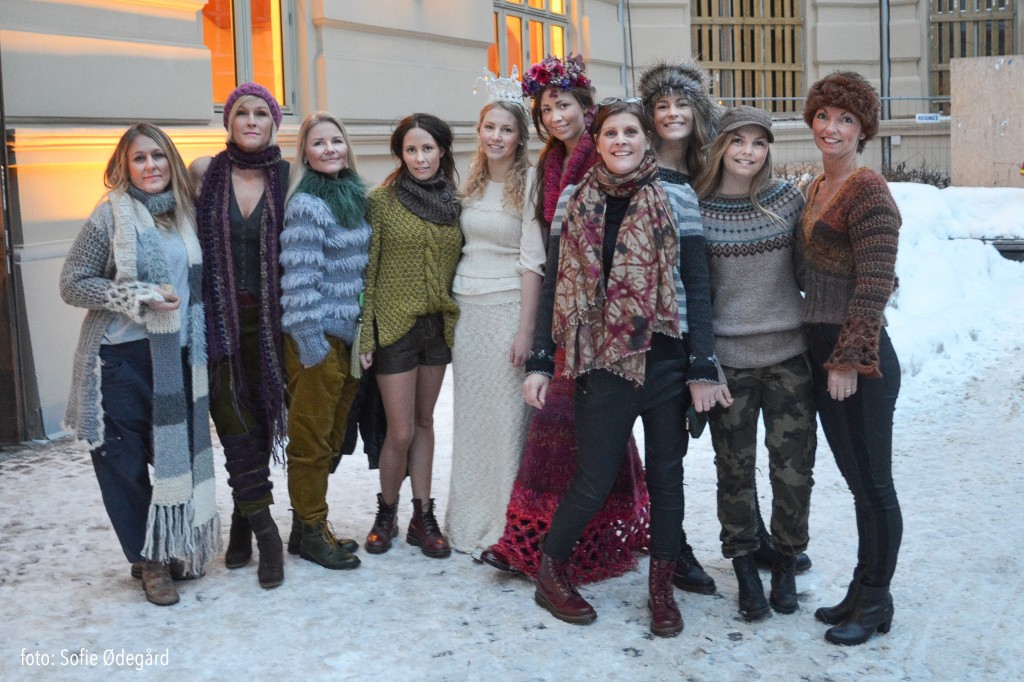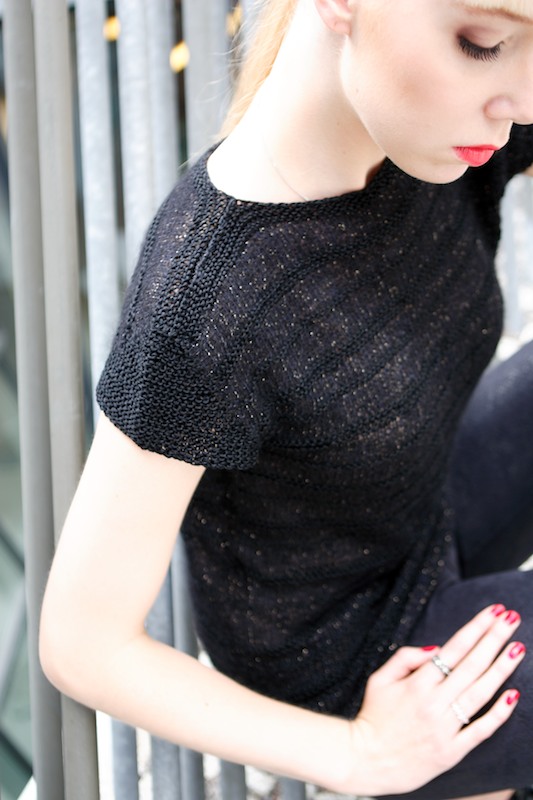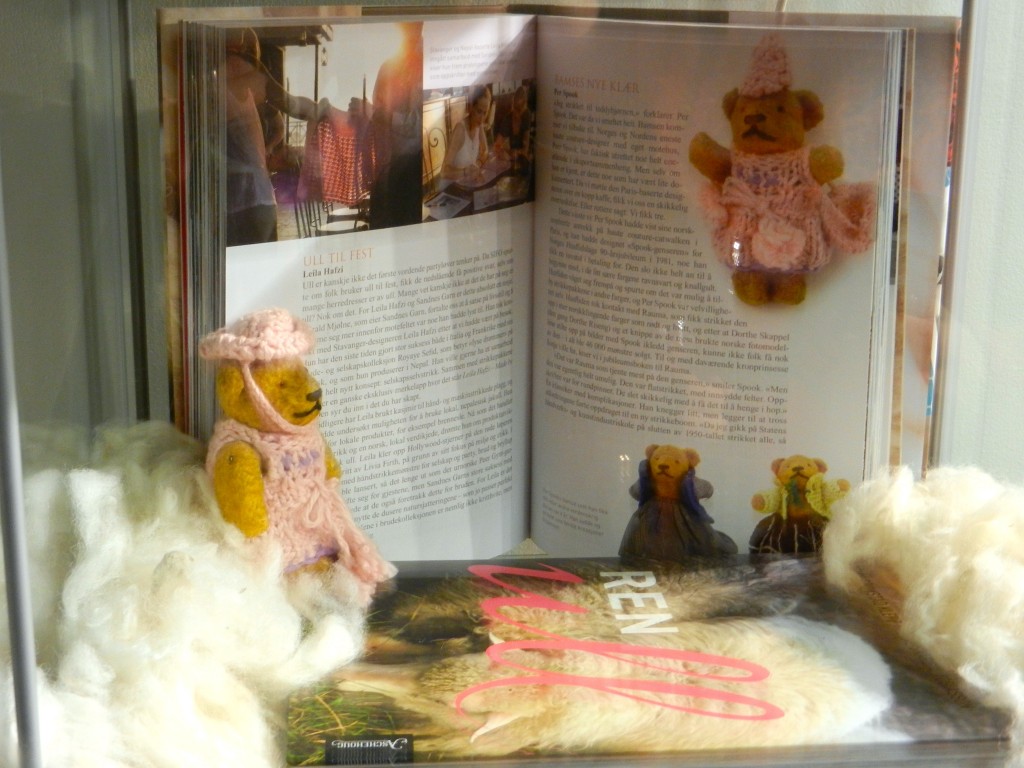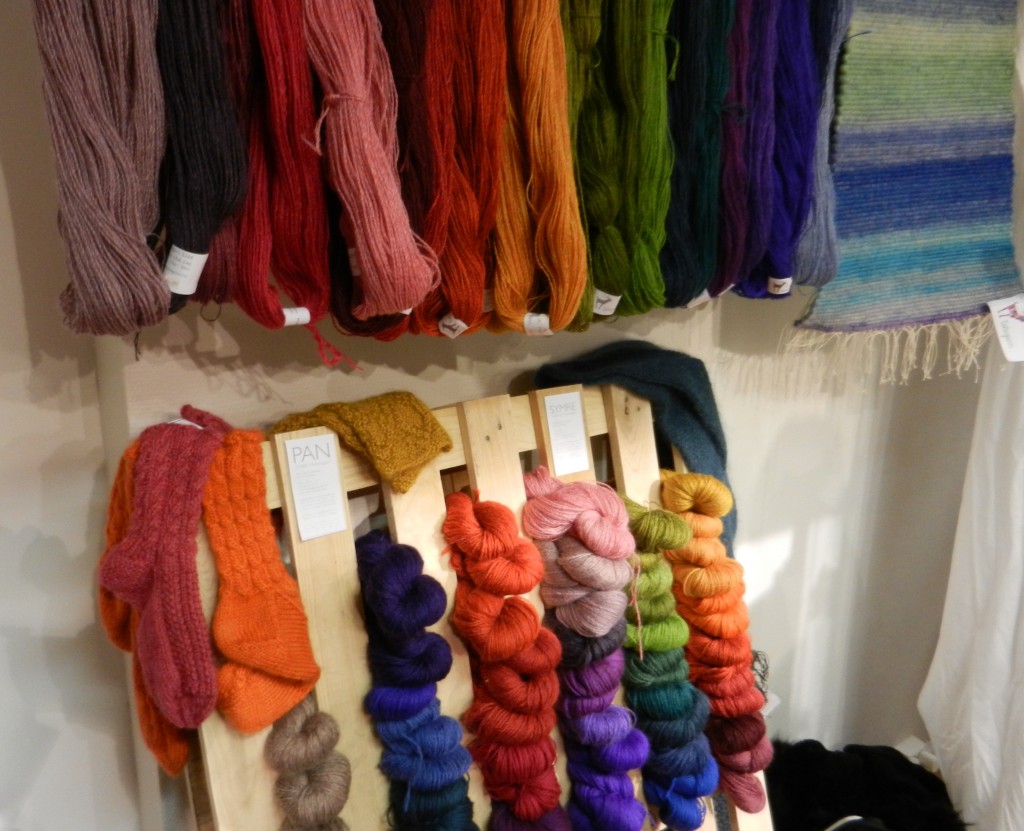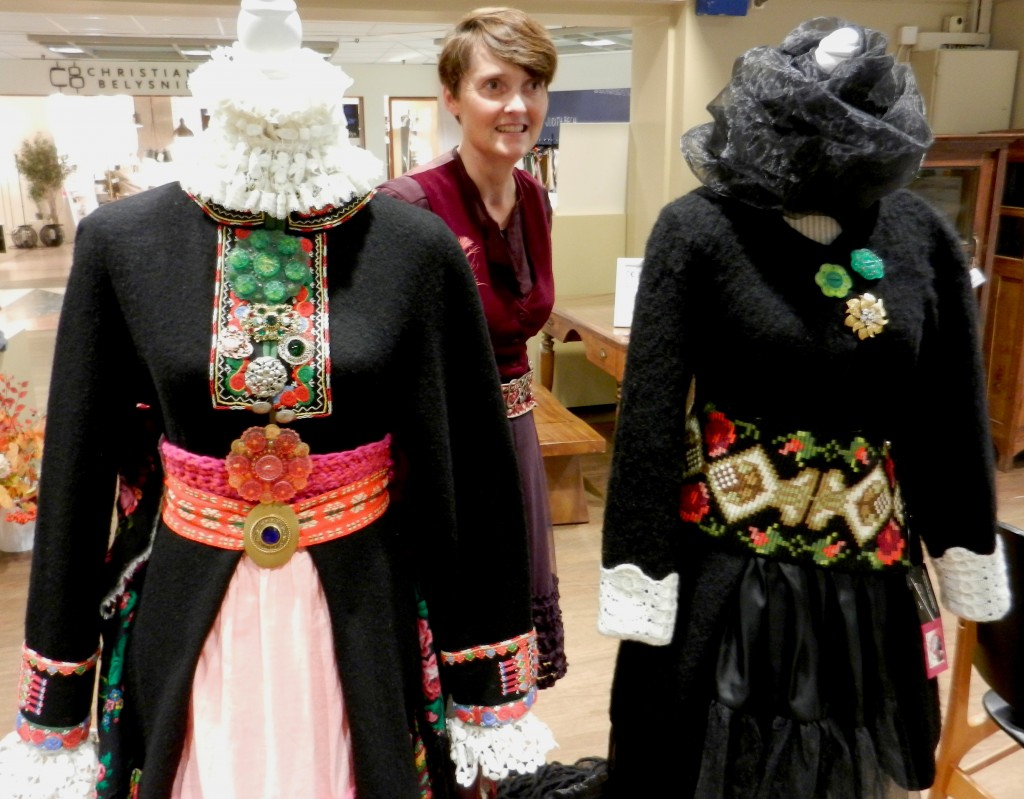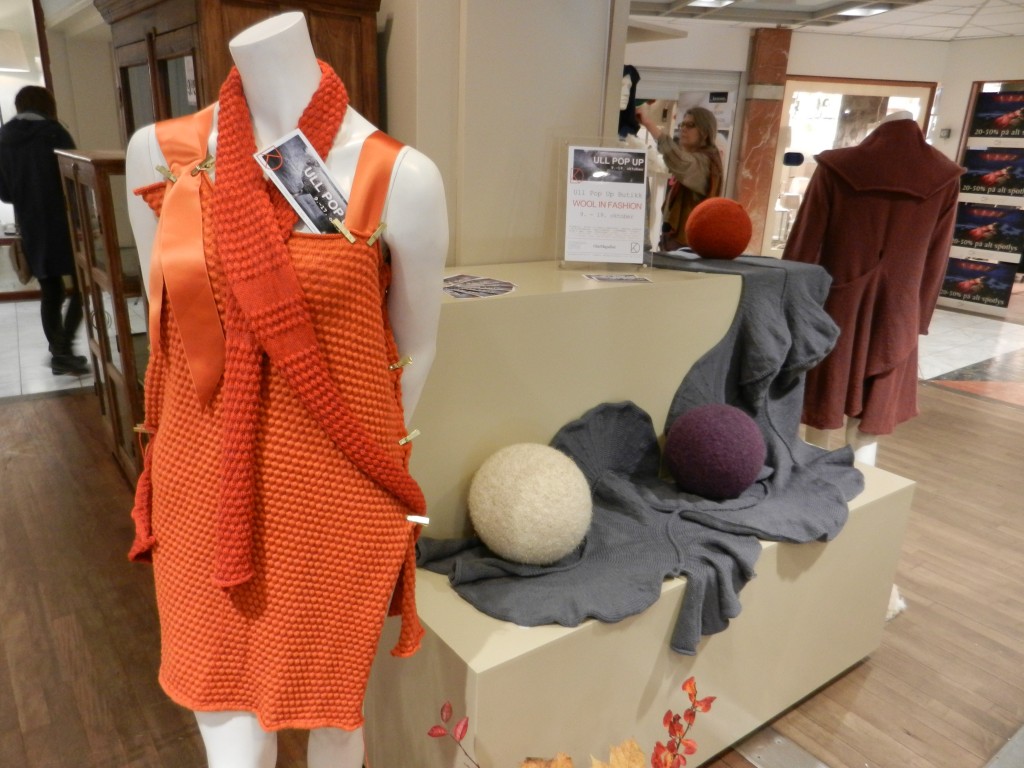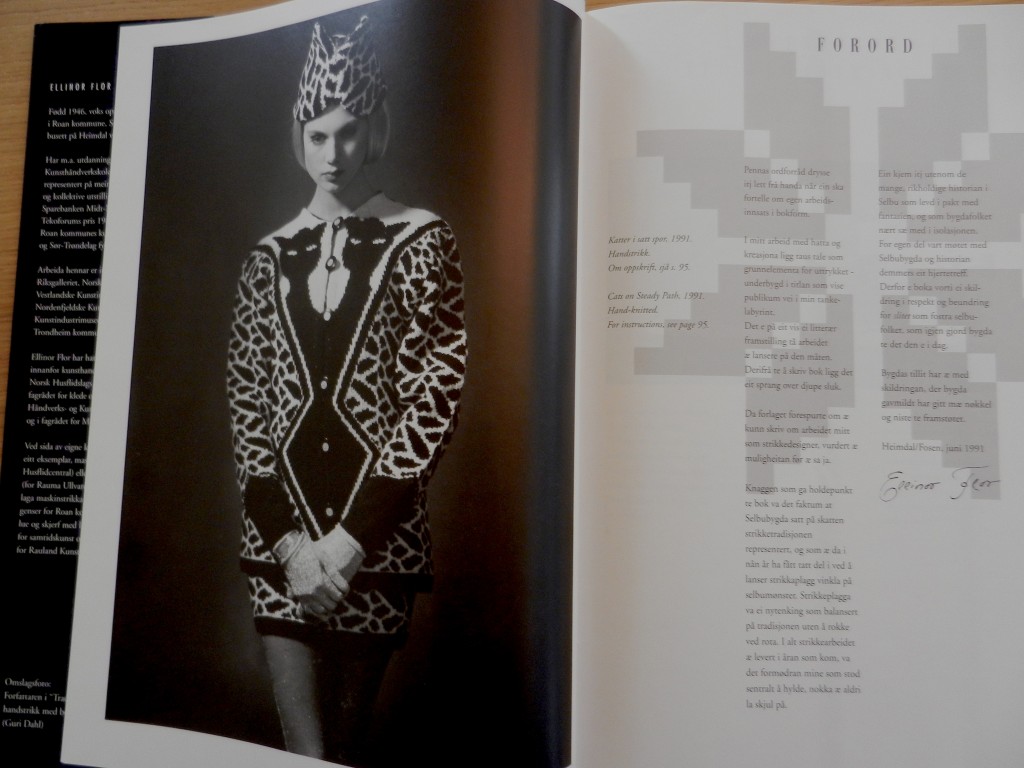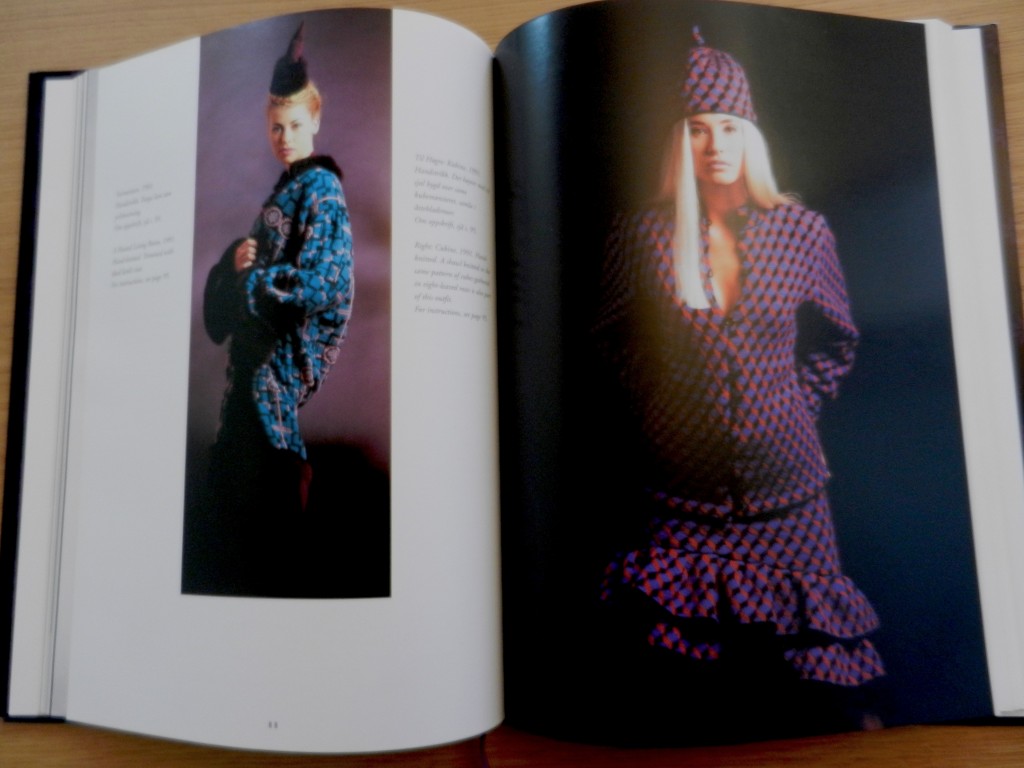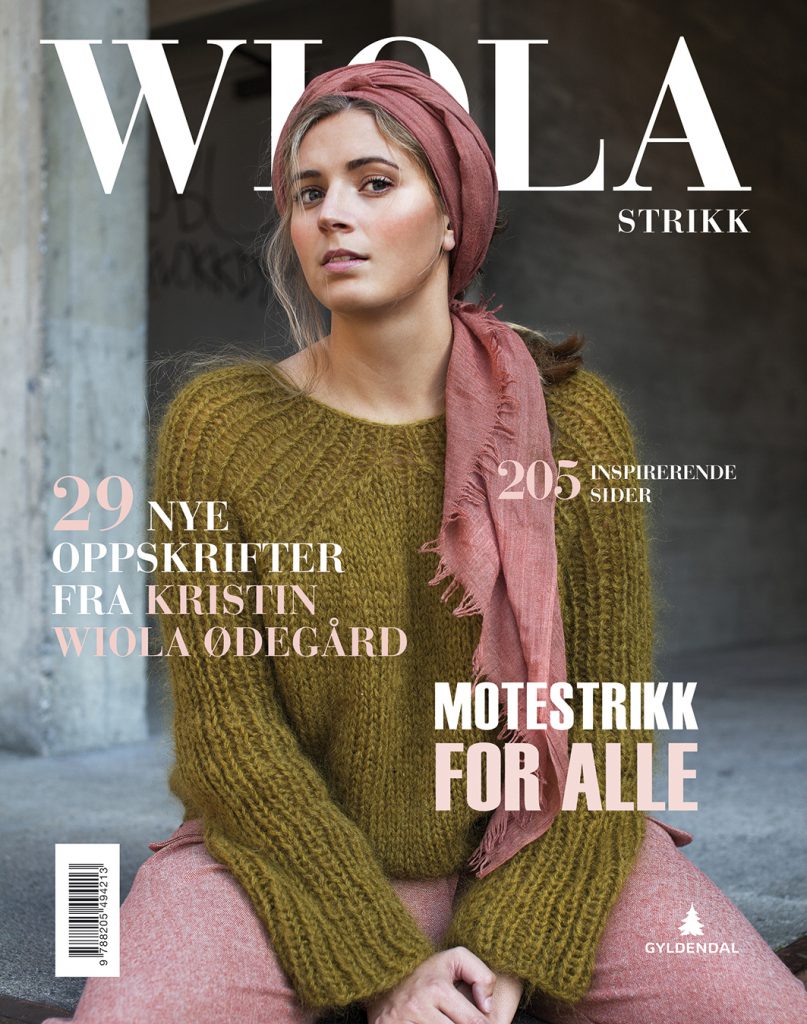 Norwegian designer Kristin Wiola Ødegård has recently published her fourth book: Wiolastrikk, considering that the first one came in 2014, I cannot help but be impressed. In 2012, I remember Kristin coming to my book launch and telling me she was working on her first book. But I digress. Just as in her previous books both of Kristin’s daughters are involved; one as a model in front of the camera and the other, Sofie Ødegård behind the camera. They are such a marvellous team; Sofie captures the essence of Kristin’s designs. Kristin has her own style always on trend with a bit of vintage thrown in. In styling her knitted designs, Kristin often ends up sewing garments to fit perfectly, if she cannot find what she is looking for. Wiolastrikk, which looks like a magazine, contains 29 new patterns; mainly knitting patterns but also a few crochet patterns. It is her kofte patterns that are the most popular ones here in Norway – take a look at Høstruta – but in the book are also garments knitted in other techniques such as lace, cables and rib. Take a look inside the book here: issuu.com. The Norwegian book is available in book stores all over Norway or can be ordered directly from the publisher Gyldendal. You will find some of her single pdf patterns translated into English and Dutch, available to buy from Ravelry.
Norwegian designer Kristin Wiola Ødegård has recently published her fourth book: Wiolastrikk, considering that the first one came in 2014, I cannot help but be impressed. In 2012, I remember Kristin coming to my book launch and telling me she was working on her first book. But I digress. Just as in her previous books both of Kristin’s daughters are involved; one as a model in front of the camera and the other, Sofie Ødegård behind the camera. They are such a marvellous team; Sofie captures the essence of Kristin’s designs. Kristin has her own style always on trend with a bit of vintage thrown in. In styling her knitted designs, Kristin often ends up sewing garments to fit perfectly, if she cannot find what she is looking for. Wiolastrikk, which looks like a magazine, contains 29 new patterns; mainly knitting patterns but also a few crochet patterns. It is her kofte patterns that are the most popular ones here in Norway – take a look at Høstruta – but in the book are also garments knitted in other techniques such as lace, cables and rib. Take a look inside the book here: issuu.com. The Norwegian book is available in book stores all over Norway or can be ordered directly from the publisher Gyldendal. You will find some of her single pdf patterns translated into English and Dutch, available to buy from Ravelry.
Tag Archives: book review
Strikketid by Marte Helgetun
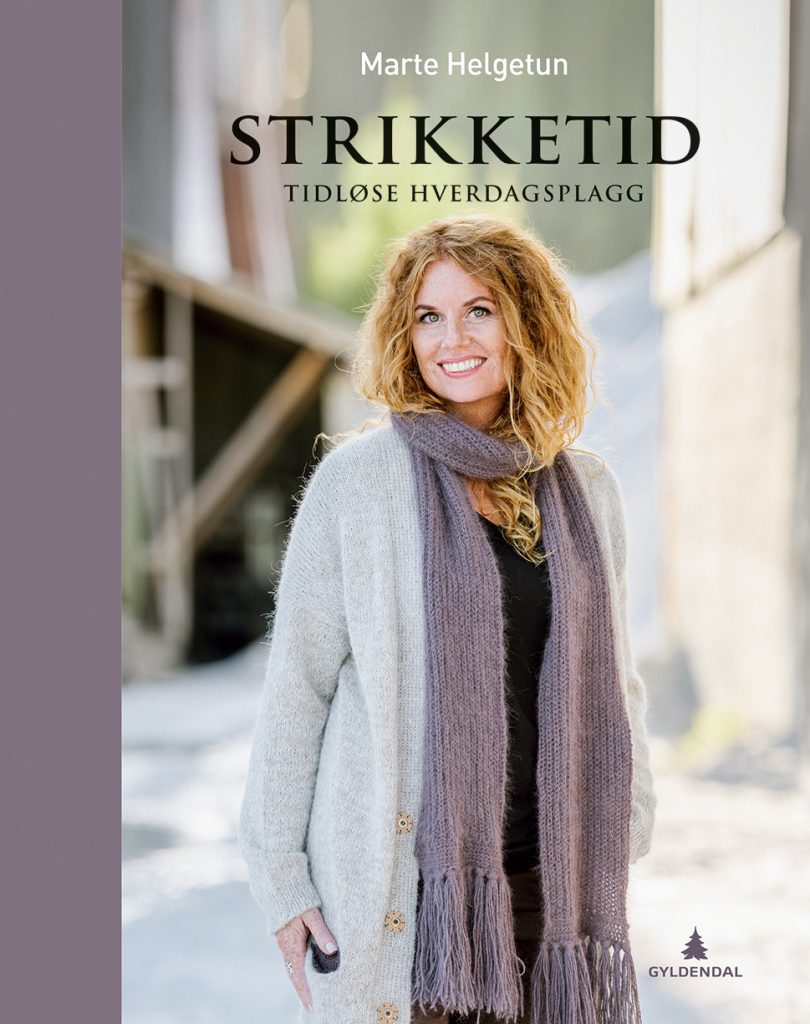 This lovely book dropped into my postbox awhile back. Strikketid. Tidløse Hverdagsplagg” is the full title in Norwegian and it translates to “Knitting time. Timeless Everyday garments”. As you can see even from the cover it does contain just that. This is Marte Helgetun’s 3. book, and I would have loved to attend the launch weekend the perfect – in my opinion – “Strikkeweekend/Knitting weekend” at Thon Hotel Vårsøg in Surnadal. The program for the weekend included presentation of the book, a fashion show, an exhibition of the garments and a visit to her farm-yarn-shop, as well as a celebration dinner. It sounded like an excellent way to spend a weekend as well as way to launch a book. There are more than 30 patterns for women in the book, all written without any abbreviations and easy to understand. There are sweaters, cardigans, dresses, skirts, hats and scarfs in the book, all in Marte’s casual elegant and edgy style.
This lovely book dropped into my postbox awhile back. Strikketid. Tidløse Hverdagsplagg” is the full title in Norwegian and it translates to “Knitting time. Timeless Everyday garments”. As you can see even from the cover it does contain just that. This is Marte Helgetun’s 3. book, and I would have loved to attend the launch weekend the perfect – in my opinion – “Strikkeweekend/Knitting weekend” at Thon Hotel Vårsøg in Surnadal. The program for the weekend included presentation of the book, a fashion show, an exhibition of the garments and a visit to her farm-yarn-shop, as well as a celebration dinner. It sounded like an excellent way to spend a weekend as well as way to launch a book. There are more than 30 patterns for women in the book, all written without any abbreviations and easy to understand. There are sweaters, cardigans, dresses, skirts, hats and scarfs in the book, all in Marte’s casual elegant and edgy style.
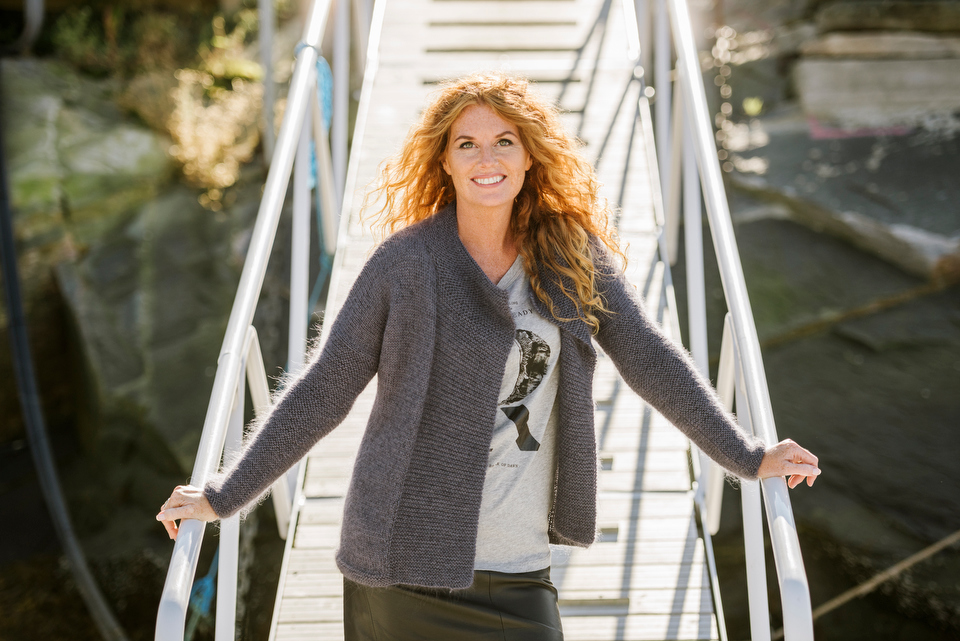 In fact you will find one of the book patterns, in Norwegian; Rillejakke free on her website. All the beautiful photos in the book are taken by Nathan W. Lediard, see lediardfoto.com. At the back of the book is a page of yarn alternatives based on gauge as well as an illustrated Strikke-ABC. You can have a look inside the Norwegian book here: issuu.com. Enjoy!
In fact you will find one of the book patterns, in Norwegian; Rillejakke free on her website. All the beautiful photos in the book are taken by Nathan W. Lediard, see lediardfoto.com. At the back of the book is a page of yarn alternatives based on gauge as well as an illustrated Strikke-ABC. You can have a look inside the Norwegian book here: issuu.com. Enjoy!
Viking Knits & Ancient Ornaments by Elsebeth Lavold
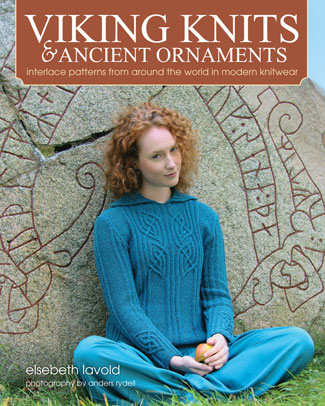 It has been a long wait for a new knitting book by Swedish designer Elsebeth Lavold, since she published the international bestseller Viking Knits in 1998. Her approach as well as use of Viking ornaments is ground breaking. Lavold invented a lifted increase to create interlace patterns rather than just to shape garments and also let the cables do the shaping to a certain degree. I admit I have a special interest, due to my own Norwegian ancestry as well as my love for cables. She has continued to research and work with the ornamental treasures and discovered how multifaceted they are. The book is beautifully photographed and richly illustrated with drawings by her partner Anders Rydell. The book contains 21 patterns; mainly sweaters and jackets for women, accessories, a few children’s garments and only one sweater for men, to some knitters disappointment see the Elsebeth Lavold Fans Group on Ravelry. All the garments are knitted in her own yarn, Elsebeth Lavold Designer’s Choice Yarns, see ingenkonst.se, which she was asked to create after her book success, distributed in the USA by Knitting Fever. And no, I have neither seen nor tested any of them but know them by reputation, especially the Silky Wool which seem to have a large group of admirers. Each chapter covers a group of Viking ornamentation with its history and location of a specific photographed item, in addition to how you would cable it e.g. loops, shown with charts as well as swatches. Not only are the knitting patterns interesting to study, so is all the history, photos, and drawings in this marvelous book. You can have a peak inside the book here: amazon.com. I found my copy at adlibris.com.
It has been a long wait for a new knitting book by Swedish designer Elsebeth Lavold, since she published the international bestseller Viking Knits in 1998. Her approach as well as use of Viking ornaments is ground breaking. Lavold invented a lifted increase to create interlace patterns rather than just to shape garments and also let the cables do the shaping to a certain degree. I admit I have a special interest, due to my own Norwegian ancestry as well as my love for cables. She has continued to research and work with the ornamental treasures and discovered how multifaceted they are. The book is beautifully photographed and richly illustrated with drawings by her partner Anders Rydell. The book contains 21 patterns; mainly sweaters and jackets for women, accessories, a few children’s garments and only one sweater for men, to some knitters disappointment see the Elsebeth Lavold Fans Group on Ravelry. All the garments are knitted in her own yarn, Elsebeth Lavold Designer’s Choice Yarns, see ingenkonst.se, which she was asked to create after her book success, distributed in the USA by Knitting Fever. And no, I have neither seen nor tested any of them but know them by reputation, especially the Silky Wool which seem to have a large group of admirers. Each chapter covers a group of Viking ornamentation with its history and location of a specific photographed item, in addition to how you would cable it e.g. loops, shown with charts as well as swatches. Not only are the knitting patterns interesting to study, so is all the history, photos, and drawings in this marvelous book. You can have a peak inside the book here: amazon.com. I found my copy at adlibris.com.
Garnglede i Rosendal
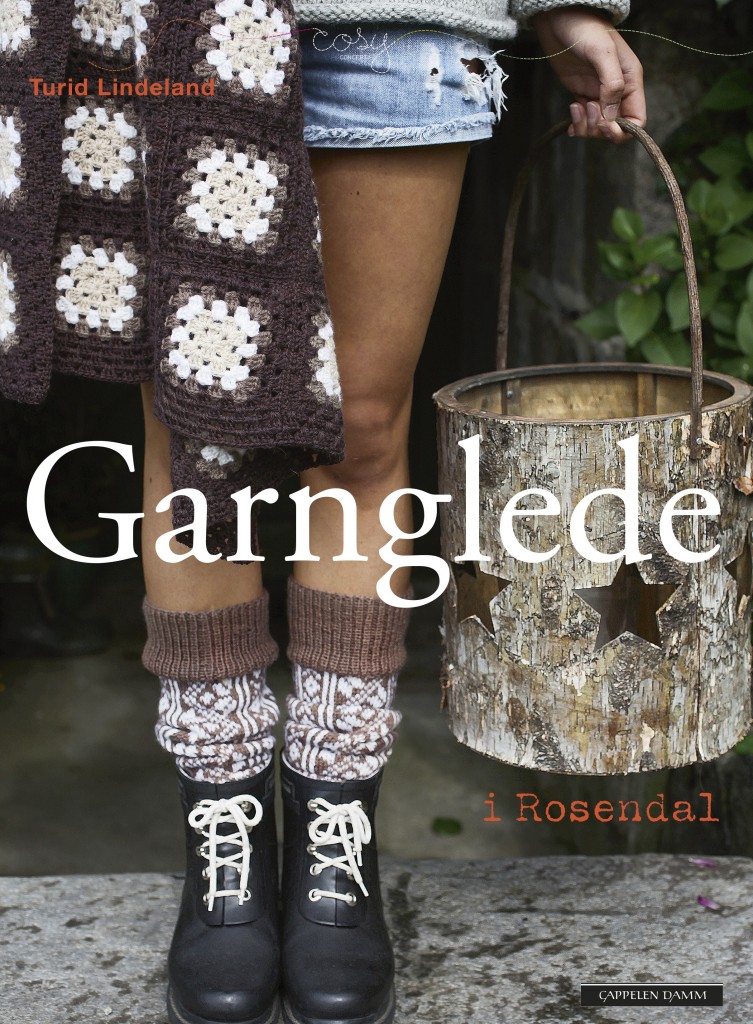 “Cosy Concept” was the working title, but “Fun with Yarn in Rosendal” is the English title of this recently launched book by Turid Lindeland published by Cappelen Damm. So far the book rights have been sold to Finland and France. “The inspiration for this book came from an old sock pattern and an old hotel in Rosendal in romantic Hardanger by one of Norway’s most well-known fjords, Hardangerfjorden. Turid Langeland has given the traditional patterns a modern twist both in terms of colour and choice of models.” The book is both beautiful and inspirational, what I found the most captivating were the photos taken from the nearby glaciers called Folgefonna, with its dramatic icy colors and shape make an outstanding backdrop for long cosy socks and cushions in the matching two coloured Fairisle patterns. See inside the book here: issuu.com. “Turid Lindeland’s vision is to be mindful of old handicraft techniques, here in terms of knitting and crocheting, and make durable products suitable for daily wear and tear. Here you’ll find patterns for blankets for young and old, socks for big and small, cushions with and without patterns, covers for chairs, photo albums, mobiles, computers and much more”. All stunningly laid out, intercepted with recipes for Rhubarb and Lime Sugar, Raspberry Ice cream and Apple Cream. So why Rosendal? It was in 2007 she and her husband bought an old hotel from 1887 in Rosedal, where she has been able to cultivate her many passions: interior design, reuse, redesign and handicrafts. Do not miss their website with amazing photos here: Rosendal Turisthotell. It is ever so comfy and inspiring. The Norwegian book is available in selected book stores and online here: Cappelen Damm.
“Cosy Concept” was the working title, but “Fun with Yarn in Rosendal” is the English title of this recently launched book by Turid Lindeland published by Cappelen Damm. So far the book rights have been sold to Finland and France. “The inspiration for this book came from an old sock pattern and an old hotel in Rosendal in romantic Hardanger by one of Norway’s most well-known fjords, Hardangerfjorden. Turid Langeland has given the traditional patterns a modern twist both in terms of colour and choice of models.” The book is both beautiful and inspirational, what I found the most captivating were the photos taken from the nearby glaciers called Folgefonna, with its dramatic icy colors and shape make an outstanding backdrop for long cosy socks and cushions in the matching two coloured Fairisle patterns. See inside the book here: issuu.com. “Turid Lindeland’s vision is to be mindful of old handicraft techniques, here in terms of knitting and crocheting, and make durable products suitable for daily wear and tear. Here you’ll find patterns for blankets for young and old, socks for big and small, cushions with and without patterns, covers for chairs, photo albums, mobiles, computers and much more”. All stunningly laid out, intercepted with recipes for Rhubarb and Lime Sugar, Raspberry Ice cream and Apple Cream. So why Rosendal? It was in 2007 she and her husband bought an old hotel from 1887 in Rosedal, where she has been able to cultivate her many passions: interior design, reuse, redesign and handicrafts. Do not miss their website with amazing photos here: Rosendal Turisthotell. It is ever so comfy and inspiring. The Norwegian book is available in selected book stores and online here: Cappelen Damm.
Hønsestrikk til folket
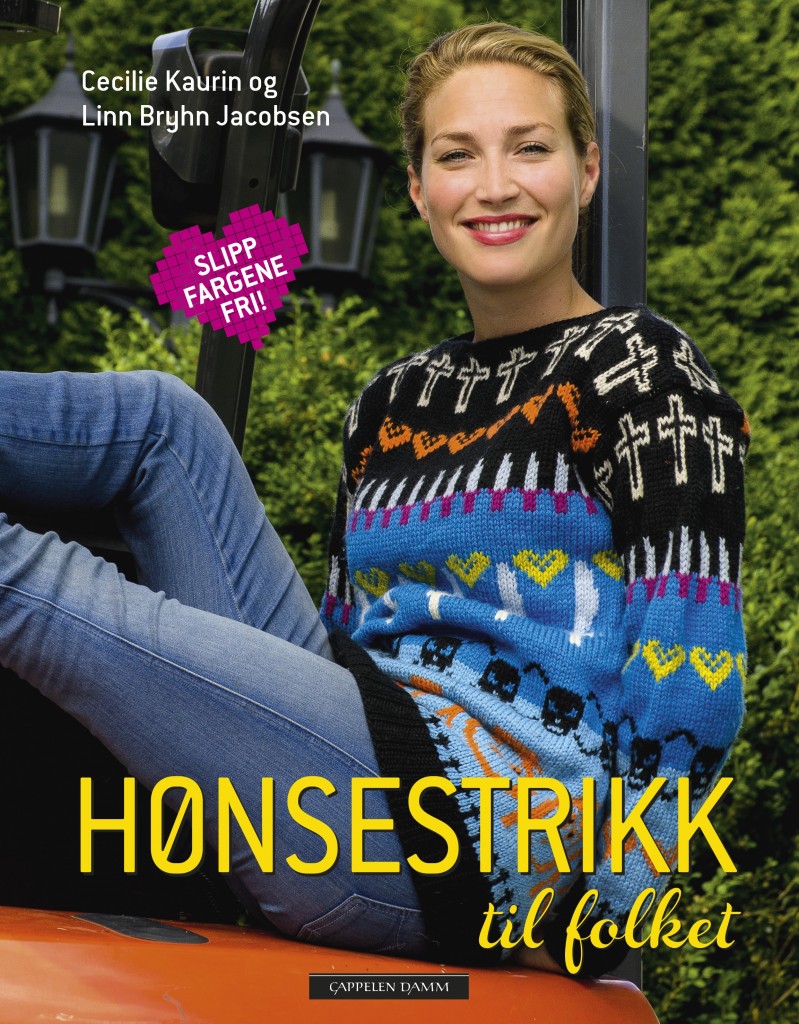 Chicken knits to the people is a direct translation from Norwegian of this popular newly published book by Cecilie Kaurin and Linn Bryhn Jacobsen, see cappelendamm. Slipp fargene fri/Let the colors loose is their encouragement to knitters here in Norway, written on a heart shaped chart with a photograph of the trendy Karpe Diem sweater on the cover of this book ring bound for easy and regular use, see my earlier post; Hobby Night at Cappelen Damm. Some knitters have even commented that they would have preferred to have the cover laminated too, so that the wear would be even less. I still have a number of my favorite patterns laminated, so I understand the request too well…
Chicken knits to the people is a direct translation from Norwegian of this popular newly published book by Cecilie Kaurin and Linn Bryhn Jacobsen, see cappelendamm. Slipp fargene fri/Let the colors loose is their encouragement to knitters here in Norway, written on a heart shaped chart with a photograph of the trendy Karpe Diem sweater on the cover of this book ring bound for easy and regular use, see my earlier post; Hobby Night at Cappelen Damm. Some knitters have even commented that they would have preferred to have the cover laminated too, so that the wear would be even less. I still have a number of my favorite patterns laminated, so I understand the request too well…
Chicken knitting has nothing to do with chickens, but is a 40- year old term invented by the Danish author and knitter Kirsten Hofstätter, who was tired of not being able to buy patterns without buying yarn, and made her own pattern book with less rigid pattern set up. She was refused by the left radical publishing firm Rød Hane/Red Cock and started her own publishing firm called Hønsetryk/Chicken print. She encouraged knitters to create and fantasize with knitting needles without strictly following a knitting pattern. Chicken knit became a term for knitting with colorful yarns, preferably waste yarn and for making your own colourwork borders. So begins the foreword to the book, and continues with how to knit creatively making up your own pattern. The patterns in the book are all knitted in the round and steeked. Not all border repeats fit the stitch number but the authors encourage you to end in the side where it is less visible. All the major borders on the body should fit, though, and you can adapt the smaller ones to fit yourself if you prefer. The book contains 23 patterns – with different variations for each one – for adults, children and accessories as well as chapters on tips and tricks and gauge/tension; personalizing your sweater; and how to make the perfect chicken hanger for your chicken knits. You will find more info and a fun free wrist warmer pattern in both Norwegian and English on their blog here: chickenknitting.blogspot and more of the projects on the preview here: Issuu.
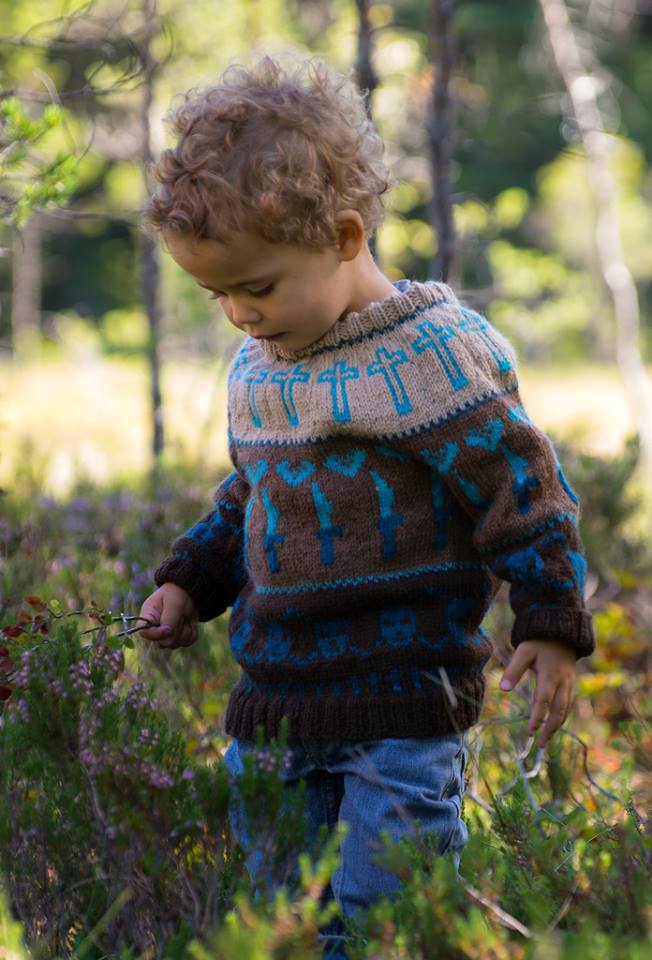 I could not resist to show a children’s version of the divine Karpe Diem sweater seeing this stunning photo. It is knitted in Mitu (50% wool, 50% alpaca, 50 g, 100 m/109 yds) a DK weight from Rauma Ullvarefabrikk, using 5 suggested colors and 3.5 mm/US 4 circular needles, see Raumaull. See other patterns from the book on the Cappelen Damm’s blog: forlagsliv. The book has been sold to a Danish publisher so far. Enjoy and start creating your own borders to make your own sweater.
I could not resist to show a children’s version of the divine Karpe Diem sweater seeing this stunning photo. It is knitted in Mitu (50% wool, 50% alpaca, 50 g, 100 m/109 yds) a DK weight from Rauma Ullvarefabrikk, using 5 suggested colors and 3.5 mm/US 4 circular needles, see Raumaull. See other patterns from the book on the Cappelen Damm’s blog: forlagsliv. The book has been sold to a Danish publisher so far. Enjoy and start creating your own borders to make your own sweater.
Strikk med raske pinner by Kristin Wiola Ødegård
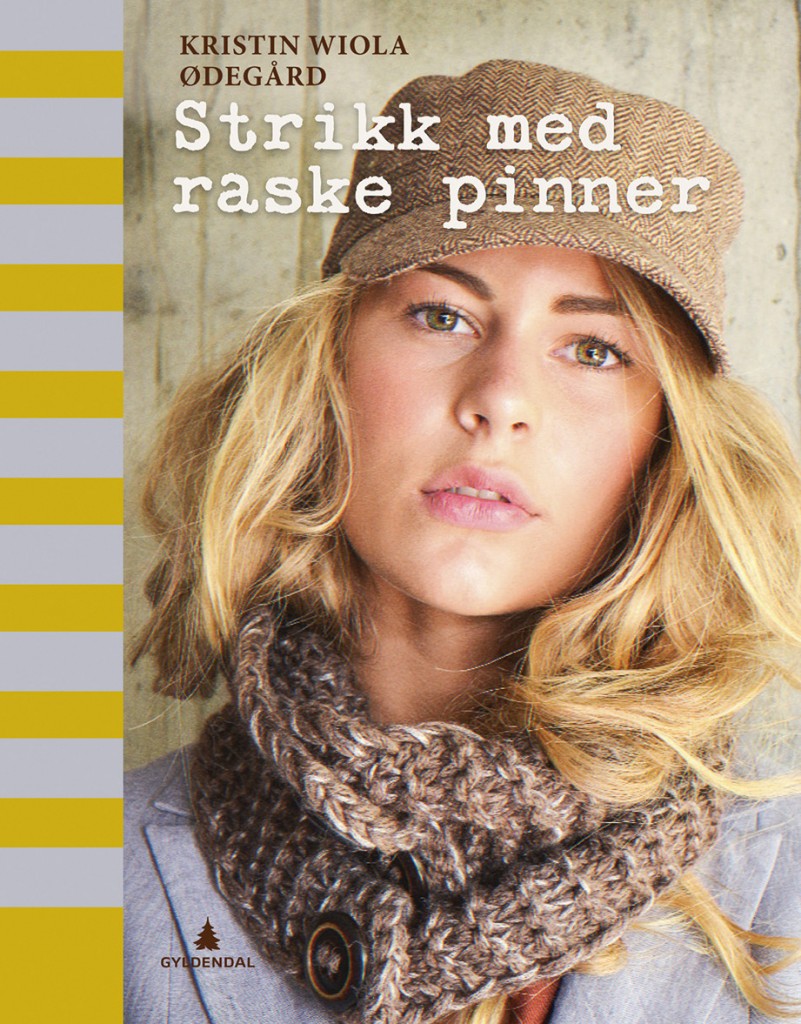 Knit with speedy knitting needles is a direct translation of Kristin Wiola Ødegård’s first knitting book title recently published by Gyldendal, containing 44 easy and playful patterns. In her preface she writes: “I love large, soft sweaters and jackets that can be worn with anything, hats in cool colors which make a simple outfit exciting, and chunky cowls that do not itch. In Strikk med raske pinner, I have gathered my favorites of lovely knitting garments that can easily be combined with your wardrobe. My vision has been to make a knitting book that can inspire the reader to make simple garments found in the fashion of today.” I have no doubt that is has been a fun project, as Kristin writes, since both her daughters have supported, and assisted her. Ida has been a stunning model, together with 3 others, and Sofie has beautifully photographed the entire book. The original setting; at a garage with its bare brick and concrete walls makes a perfect setting for all the soft knits as well as the borrowed tractor. The book launch was last Saturday, and it was packed with 200 people attending, not wanting to miss the fashion show; the yarn store Nøstet Mitt‘s stand; the opportunity to both see the garments close, and to win prizes such as yarn kits and ready made hats.
Knit with speedy knitting needles is a direct translation of Kristin Wiola Ødegård’s first knitting book title recently published by Gyldendal, containing 44 easy and playful patterns. In her preface she writes: “I love large, soft sweaters and jackets that can be worn with anything, hats in cool colors which make a simple outfit exciting, and chunky cowls that do not itch. In Strikk med raske pinner, I have gathered my favorites of lovely knitting garments that can easily be combined with your wardrobe. My vision has been to make a knitting book that can inspire the reader to make simple garments found in the fashion of today.” I have no doubt that is has been a fun project, as Kristin writes, since both her daughters have supported, and assisted her. Ida has been a stunning model, together with 3 others, and Sofie has beautifully photographed the entire book. The original setting; at a garage with its bare brick and concrete walls makes a perfect setting for all the soft knits as well as the borrowed tractor. The book launch was last Saturday, and it was packed with 200 people attending, not wanting to miss the fashion show; the yarn store Nøstet Mitt‘s stand; the opportunity to both see the garments close, and to win prizes such as yarn kits and ready made hats.
This delicate yoked sweater is knitted in Alpaca Mix from Drops in a main color with 5 contrast colors and decorative beads, using a 4.5 mm/US 7. It was the most popular yarn kit donated by Tjorven, the yarn shop, where Kristin works. She is well aware over how much remains most knitters have in their stash, and encourages everyone to play with them to make your own yarn by working several strands at the same time. Why not add another strand when you need to add width instead of increasing? See the glimpse of the red multi coloured dress in the last photo; you start working the skirt from the hip using 2 strands and a 7 mm/US 10.75, add another strand and change to a 10 mm/US 15, then finally add a fourth strand and change to a 15 mm/US 19. A crocheted edge graces the long dress.
 Marvelous leaf pattern combined with garter stitch in a chunky yarn gives this poncho with long sleeves, and hat a fabulous stitch definition. Both are knitted in a mole coloured Eskimo from Garnstudio using a 8 mm/US 11 needles. There are numerous other hats to choose from and they proved so popular at the book launch that Nøstet Mitt sold out of Puno Alpakka from Rauma. The yarn is also one of the options for the cowl on the cover.
Marvelous leaf pattern combined with garter stitch in a chunky yarn gives this poncho with long sleeves, and hat a fabulous stitch definition. Both are knitted in a mole coloured Eskimo from Garnstudio using a 8 mm/US 11 needles. There are numerous other hats to choose from and they proved so popular at the book launch that Nøstet Mitt sold out of Puno Alpakka from Rauma. The yarn is also one of the options for the cowl on the cover.
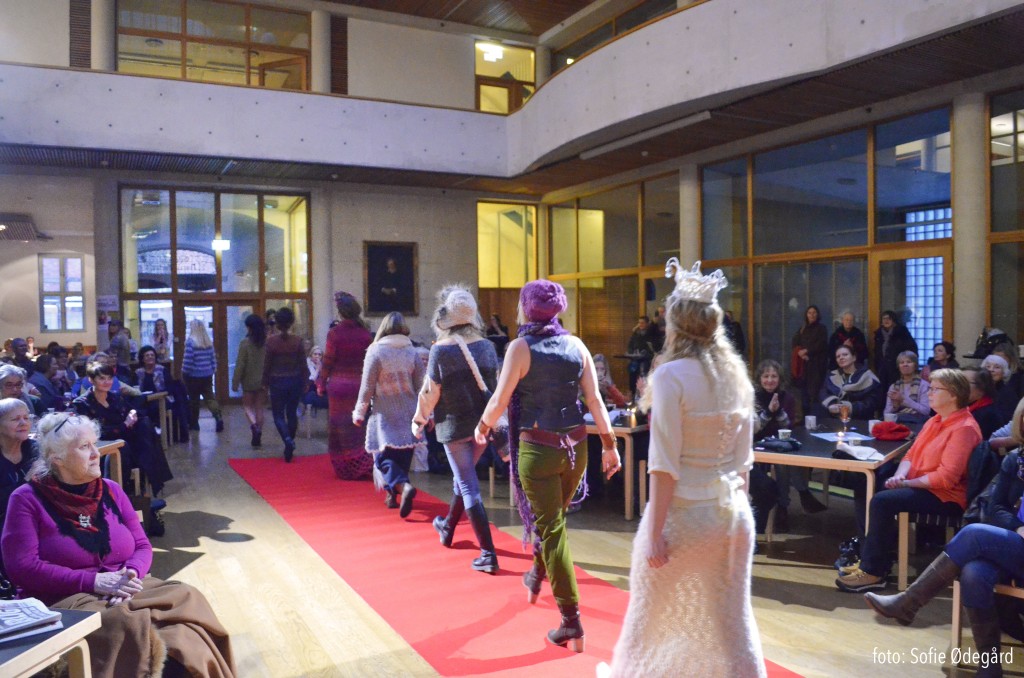 Kristin designs, and makes clothes too, and decided to make all the clothes for the fashion show on the book launch. She is number four from the right, her daughter Ida is number two from the right. No wonder that Kristin’s second book will be published next year, really! Until then, I suggest you enjoy her first, and learn from the Knitting and Crochet School at the back. You will find more photos here: Gyldendal.
Kristin designs, and makes clothes too, and decided to make all the clothes for the fashion show on the book launch. She is number four from the right, her daughter Ida is number two from the right. No wonder that Kristin’s second book will be published next year, really! Until then, I suggest you enjoy her first, and learn from the Knitting and Crochet School at the back. You will find more photos here: Gyldendal.
Seamless Knitting by Anna Verschik
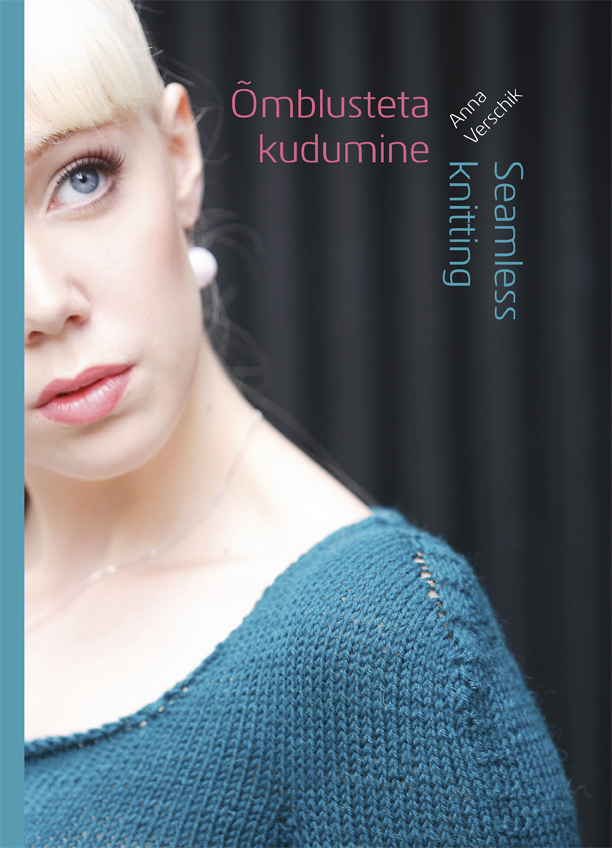 I have been waiting impatiently for this beautiful book to arrive from the Apollo Bookstore in Tallinn, Estonia. Anna Verschik is a linguistics professor, and an avid designer with her own blog; “kuduja” which means knitter in Estonian. It is fascinating reading, as you can imagine. Well, finally her book arrived: and I am ever so pleased to be able to study it in detail, especially the brilliant chapter on constructions. As Anna says in her introduction: “My knitting is guided by three keywords – construction, proportion, intuition.” She favors top down but also works sideways, or even combines the two. When it comes to proportion everyone knows what suits them, and what a suitable length is, especially easy to test when knitting top down, claims Anna. Quite often our intuition prompts whether a garment is suitable for you or not or whether a style is worth trying. “Quite naturally the knits in the book reflect my taste because I have created them. My style balances on the edge of minimalism, stitch patterns and adornments are not plentiful – I am always careful not to overdo it. However, if you like colourwork, busy patterns and rich style, this does not prevent you from trying out the constructions described here. The patterns in this book are meant as an illustration, and not a goal in itself. You can immediately pick a knit you like and make it. But before that I recommend that you read the read the overview of constructions that I have used.” There are 14 trendy patterns, all in size S to XL with generous charts, knitted using from a 3 mm/US 2.5 to a 5.5 mm/US 9, some with negative ease that stretches when worn while others with positive ease. See all of Anna’s gorgeous designs here: Ravelry.com/designers/anna-kuduja.
I have been waiting impatiently for this beautiful book to arrive from the Apollo Bookstore in Tallinn, Estonia. Anna Verschik is a linguistics professor, and an avid designer with her own blog; “kuduja” which means knitter in Estonian. It is fascinating reading, as you can imagine. Well, finally her book arrived: and I am ever so pleased to be able to study it in detail, especially the brilliant chapter on constructions. As Anna says in her introduction: “My knitting is guided by three keywords – construction, proportion, intuition.” She favors top down but also works sideways, or even combines the two. When it comes to proportion everyone knows what suits them, and what a suitable length is, especially easy to test when knitting top down, claims Anna. Quite often our intuition prompts whether a garment is suitable for you or not or whether a style is worth trying. “Quite naturally the knits in the book reflect my taste because I have created them. My style balances on the edge of minimalism, stitch patterns and adornments are not plentiful – I am always careful not to overdo it. However, if you like colourwork, busy patterns and rich style, this does not prevent you from trying out the constructions described here. The patterns in this book are meant as an illustration, and not a goal in itself. You can immediately pick a knit you like and make it. But before that I recommend that you read the read the overview of constructions that I have used.” There are 14 trendy patterns, all in size S to XL with generous charts, knitted using from a 3 mm/US 2.5 to a 5.5 mm/US 9, some with negative ease that stretches when worn while others with positive ease. See all of Anna’s gorgeous designs here: Ravelry.com/designers/anna-kuduja.
I was keen to see the rest of the pullover on the cover, and was very pleased to look at all the artistic photos on this website: siimvahur. Real Green is a sweater with a large neck opening and a central lace panel, knitted to be worn with negative ease. The pullover is knitted top-down and the pattern is easily divided into steps with clear instructions. The yarn used is Jil from G-B Wolle, 100% wool, 50 g/125 m, using 3.5 mm needles. Anna recommends “using several pairs of circular needles so that you can try on the garment as you go.”
Black glitter is a mohair and cotton-rayon blend top with positive ease, and a perfect example of how Anna’s minimalistic yet trendy style. Three yarns are used, but only two are held together at the same time to make up the strips: Rowan Kidsilk Haze (70% kid mohair, 30% silk, 25 g/210 m), Glitter (thin glittering thread suitable for embroidery or sewing) and Katia Brisa (60% cotton, 40% rayon, 50 g/125 m). The top is knitted using 4 mm, several pairs of circular needles are recommended for trying on, as it is knitted top-down.
Two in one. “Knits with the same construction and stitch pattern but made from different yarns. Gauge in width is the same in both yarns, which yields two-in-one effect.” Both the sweater and the top (sleeveless) are knitted sideways. Photographed here is the sweater knitted in a multicolored Aade Long 8/2 (100% wool, 100 g/400 m), using 3.5 mm needles. Anna is one of four designers in the Artemis Adornments Group on Ravelry, where she runs her test knits and knit alongs. You will find her there as “kuduja”, do join her!
Finish-Free Knits by Kristen Tendyke
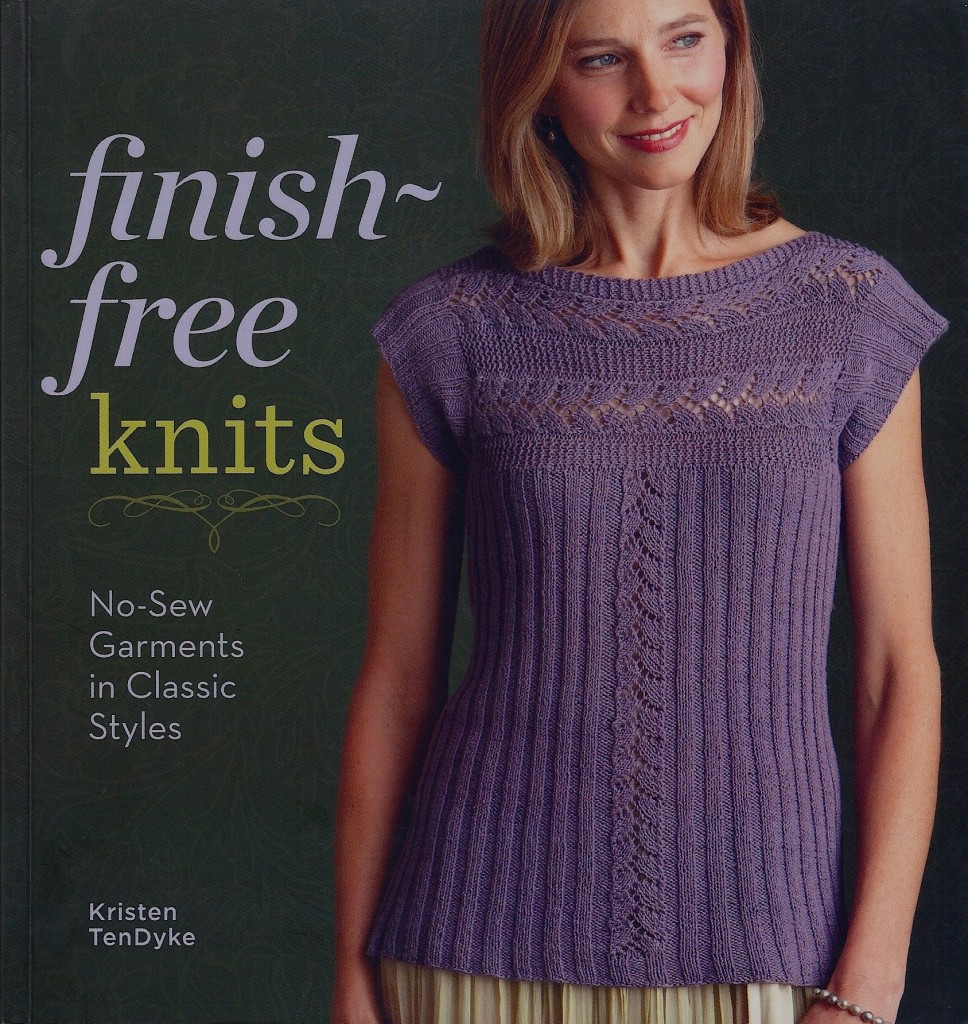 I know at lot of knitters who prefer to minimize the amount of finishing and especially avoid sewing if they can. Kristen Tendyke encourages every knitter to try an unfamiliar technique in her introduction, and I want to see what I can learn. Beginning a shrug with the cable panel at the centre of the back and then picking up stitches on each side of the panel is a smart solution, I had not considered in any detail. While shaping lace by working with different needle sizes is a technique I know and have used. There are several top-down projects worth studying as well as tips on how to avoid puckering at the underarms. My favorite part of the book is how to shape set-in sleeves while working in the round and it will be my homework for now. At Amazon you can see inside the book: Finish-Free-Knits-No-Sew-Garments-Classic and on her website you can see all the 20 projects presented: kristentendyke. Kristen Tendyke is also an technical editor for the digital magazine Clotheshorse where my second pattern just have been featured. More details will follow.
I know at lot of knitters who prefer to minimize the amount of finishing and especially avoid sewing if they can. Kristen Tendyke encourages every knitter to try an unfamiliar technique in her introduction, and I want to see what I can learn. Beginning a shrug with the cable panel at the centre of the back and then picking up stitches on each side of the panel is a smart solution, I had not considered in any detail. While shaping lace by working with different needle sizes is a technique I know and have used. There are several top-down projects worth studying as well as tips on how to avoid puckering at the underarms. My favorite part of the book is how to shape set-in sleeves while working in the round and it will be my homework for now. At Amazon you can see inside the book: Finish-Free-Knits-No-Sew-Garments-Classic and on her website you can see all the 20 projects presented: kristentendyke. Kristen Tendyke is also an technical editor for the digital magazine Clotheshorse where my second pattern just have been featured. More details will follow.
Ulluka – Campaign for Wool Week
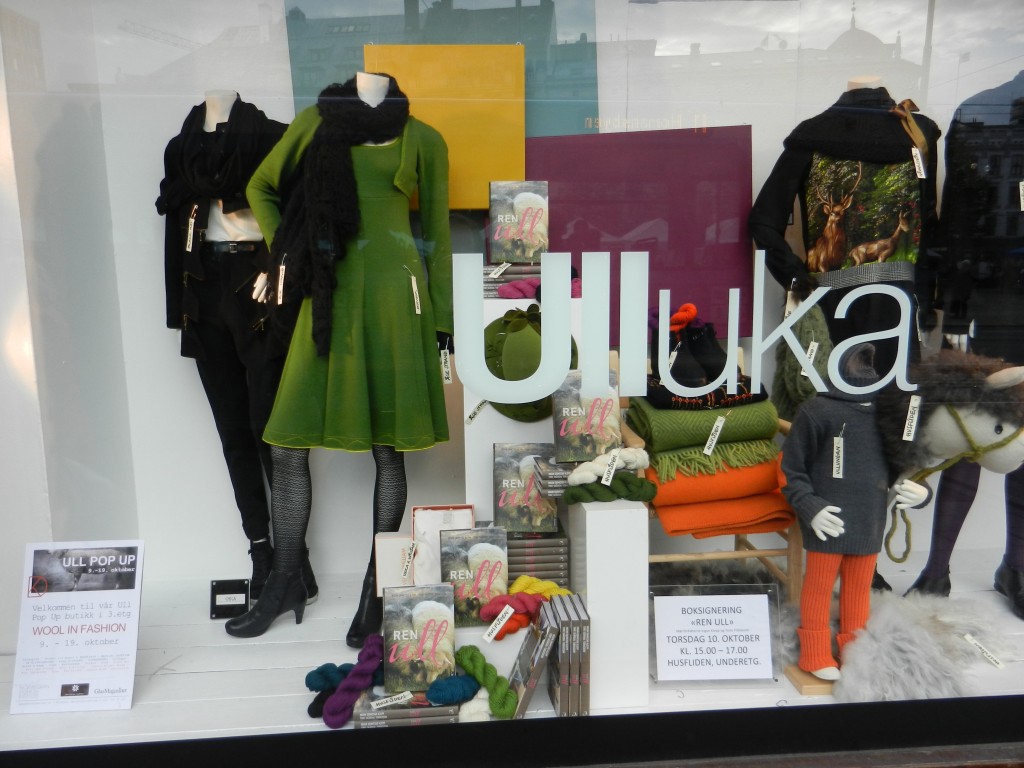 It is that time of year again, the Campaign for Wool Week or Ulluka as we simply call it. I was delighted to be invited to the launch of the Wool in Fashion Pop-up shop at Glasmagasinet and the book launch of Ren Ull/Pure Wool last Tuesday. The shop is a co-operation between Designerkollektivet and Norwegian Fashion Institute, it represents more than 20 designers who work with wool and focuses on design talents among them: Makeløs reDESIGN, Telespinn, Sorl ved Strand and Judith Bech. The book is by Tone Skårdal Tobiassen – journalist and newly converted wool-fluff – and Ingun Grimstad Klepp, an ethnologist at Sifo, who has spent 15 years researching clothes habits and sustainability. I would have liked to share Ingun’s colourful crochet dress in green and blue stripes which had sheep walking across it but it was very crowded, and she was extremely popular. We were all given a small piece of yarn – a very appropriate identity tag – on entering which allowed us to venture outside the shop with our glass of wine or beer. The book covers the road from sheep to products, kills myths like all wool is itchy, tells wool stories never before told nor collected, and presents acknowledged designers, published by Aschehoug. A must-have in other words!
It is that time of year again, the Campaign for Wool Week or Ulluka as we simply call it. I was delighted to be invited to the launch of the Wool in Fashion Pop-up shop at Glasmagasinet and the book launch of Ren Ull/Pure Wool last Tuesday. The shop is a co-operation between Designerkollektivet and Norwegian Fashion Institute, it represents more than 20 designers who work with wool and focuses on design talents among them: Makeløs reDESIGN, Telespinn, Sorl ved Strand and Judith Bech. The book is by Tone Skårdal Tobiassen – journalist and newly converted wool-fluff – and Ingun Grimstad Klepp, an ethnologist at Sifo, who has spent 15 years researching clothes habits and sustainability. I would have liked to share Ingun’s colourful crochet dress in green and blue stripes which had sheep walking across it but it was very crowded, and she was extremely popular. We were all given a small piece of yarn – a very appropriate identity tag – on entering which allowed us to venture outside the shop with our glass of wine or beer. The book covers the road from sheep to products, kills myths like all wool is itchy, tells wool stories never before told nor collected, and presents acknowledged designers, published by Aschehoug. A must-have in other words!
This treasured teddy is a very special teddy, it belongs to Per Spook of Haute Couture fame and he made his first clothes for it. The authors asked if he can knit and the answer was; “Yes, of course!”. The teddy was on a one-day loan only to the pop-up shop with his suitcase of garments displayed, you can see some of them pictured above in the book. The teddy was given to Per Spook just after WW2 when he was 6 years old… Here is his Winter 89/90 collection, see nasjonalmuseet.
I was drawn to the beautiful sheen of this mohair yarn from Telespinn. Here is their own description of it: “Symre is named after the flower Symre which there are several kinds of in Svartdal (in Telemark). Symre knitting yarn is a thin 2-ply knitting yarn which is very soft and shiny. Symre is spun of fiber from young mohair goats.” See more on their website: Telespinn.
See what Kristin E. Halkjelsvik, Makeløs/Exceptional reDESIGN, can do; the belt to the right is a former embroidered wall hanging, while her modern take on the Setesdal costume has both traditional silver brooches and new brilliantly coloured ones made in plastic by artist Siri Berrefjord part of the Designerkollektivet as well as stunning fabric combinations! Well, exceptional is part of her name and I was delighted to meet her outside of Facebook! See photos from her latest fashion show focusing on recycling of garments, cloth and traditional women’s handicraft called Redesign goes Jugend, here: glamor-st-moteshow.
I was also delighted to meet designer Sissel Strand behind the brand Sorl ved Strand whose garment construction I admired at the Designerkollektivet shop. I was also in good company, accompanied by another handknit designer, now employed by the yarn company Du Store Alpakka, Sidsel J. Høivik whose knitting book I love, see my blog post: lekre-masker-og-lekne-sting! A perfect way to spend an evening, in other words. The Wool in Fashion Pop-up Shop will stay until the 19th October, so if you are in Oslo, you know where to go…
Ellinor Flor
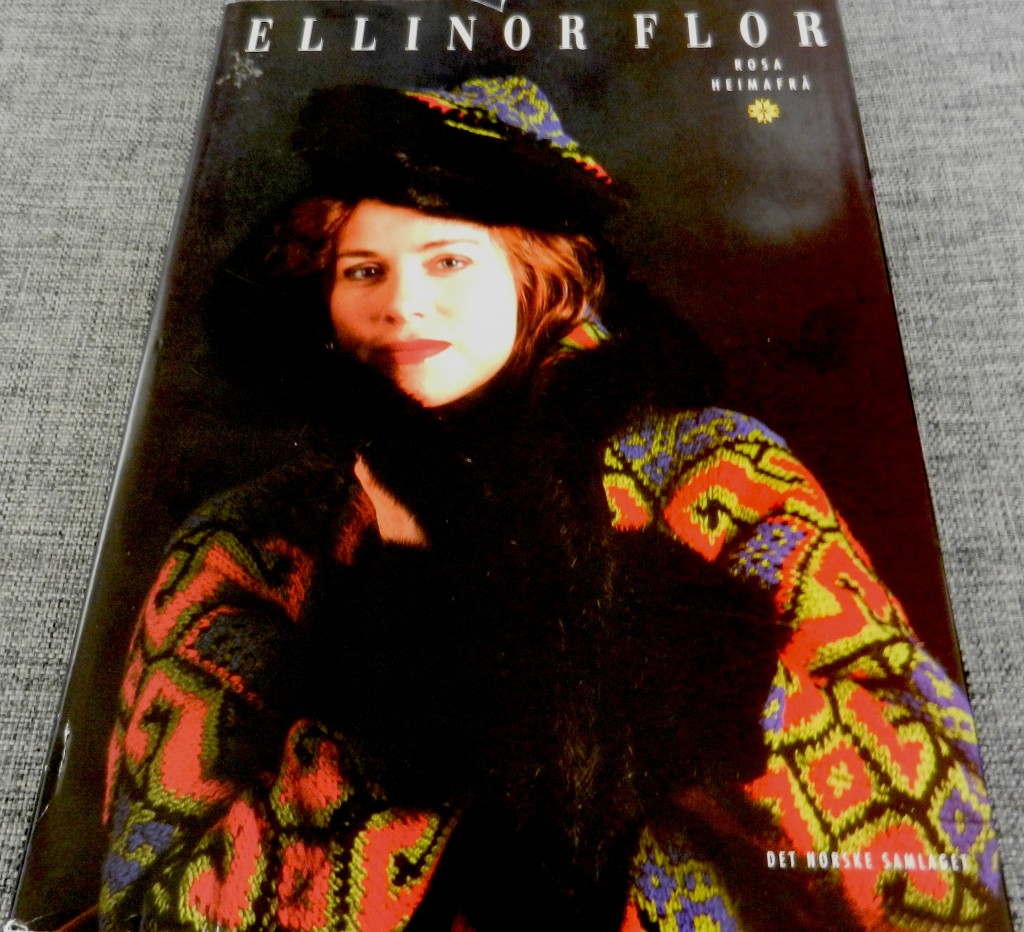 Ellinor Flor is a Norwegian Textile Artist, well known for her hat designs. They are closest to her heart because they shroud your thoughts and dreams, she explains in this astonishing but old television clip from 1985, see youtube. Even if you do not understand the language, it is worth looking at the hats and magnificent outfits, including knits. Yes, Ellinor Flor did published a knitting book, it is mind-blowing but not new, published by Samlaget in 1991, and it is what I wanted to share; Rosa Heimafrå/Native Rose. Not only does it contain 28 patterns, beautifully photographed but also the knitting history of the Selbu traditional pattern, and a selection of Ellinor Flor’s selected exhibition work. All the photos have captions in English, while the remaining text is written in dialect and New-Norwegian. The book is still available from bookstores in Norway and from the publisher: Samlaget.
Ellinor Flor is a Norwegian Textile Artist, well known for her hat designs. They are closest to her heart because they shroud your thoughts and dreams, she explains in this astonishing but old television clip from 1985, see youtube. Even if you do not understand the language, it is worth looking at the hats and magnificent outfits, including knits. Yes, Ellinor Flor did published a knitting book, it is mind-blowing but not new, published by Samlaget in 1991, and it is what I wanted to share; Rosa Heimafrå/Native Rose. Not only does it contain 28 patterns, beautifully photographed but also the knitting history of the Selbu traditional pattern, and a selection of Ellinor Flor’s selected exhibition work. All the photos have captions in English, while the remaining text is written in dialect and New-Norwegian. The book is still available from bookstores in Norway and from the publisher: Samlaget.
It is hard not to be captivated by her designs; bold colours with strong geometric shapes. These photos show four of the hand-knitted designs in the book and the cover shows Ellinor Flor modelling her own design; a coat trimmed with mink fur. All the designs are knitted in pure wool yarn from Rauma, mainly Finull (4-ply/fingering weight – see raumaull) and most of them using 3 mm/US 2.5 needles. A book to treasure and to be inspired by.


